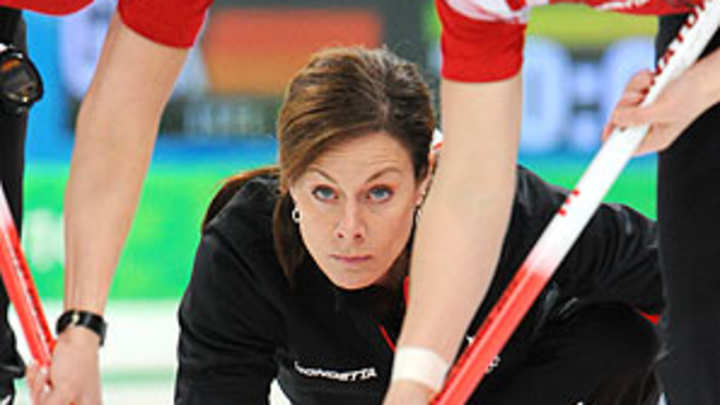Everybody must get stones: Why curling is the Olympics' best party


VANCOUVER, British Columbia -- Carl Lewis stopped by and declared himself a fan, as did King Harald of Norway. Dwight Schrute is keeping track of the goings-on at this venue. So I stopped by the Olympic Centre to find out what all the buzz was about. What it boils down to, I've concluded, is curling people know how to party.
I'm not necessarily talking about the heavily-favored Canadian men's team, which charged through round-robin play with a 9-0 record and will face Sweden in Thursday's semifinal. Team Canada's idea of a scintillating night is a good game of whist before bed.
"You want to see a competitive team," said team member Marc Kennedy, "you just gotta see us play cards against one another."
If you are tempted to reply, "Yes, Marc, that would probably be more interesting than sitting through 90 minutes of curling," that can only mean one thing: You've never seen curling in person.
Give it a chance. A sampler of what I saw and heard on my first day at the Olympic Centre:
• Nearly 6,000 fans performing a highly creditable "Wave" (It stalled briefly while passing over a VIP section that included IOC president Jacques Rogge, who was resting his chin in his hand like Rodin's "Thinker," and never cracked a smile.)
• The strident, red argyle trousers sported by Team Norway, whose members enjoyed a 10-minute audience with their monarch, King Harald, before the match. Presented with a pair of those same loud pants, the King was urged to try them on. "Maybe later," came the royal reply.
• The shouted request, from several different men, to Cheryl Bernard, skip of the Canadian women's team, "Marry me, Cheryl!"
Of course it's baffling at first, the sight of earnest adults sliding granite stones down a sheet of ice toward a big bull's-eye called "the house." Accompanying the "stone" are the "sweepers," who frantically rub the ice with short-bristled brushes called brooms. (In the old days, they used actual brooms. The equipment changed; the name stuck).
"The ice is pebbled," explained James Prette, who was sitting behind me on Tuesday as the home team put the wood to China, 10-3. "When you sweep, you're melting those little pebbles, which allows the stone to slide faster."
"Curling is huge in this country," says Prette, who lives in Vancouver but grew up in Saskatoon. "Especially in the prairie provinces. When you're too old for hockey, you curl."
How huge? There are 1.3 million players worldwide; 1.1 million of them are in Canada, whose men's team could find itself squaring off against preposterously pantalooned Norway in Saturday's final. The Canadian women, led by Cheryl "Last Shot" Bernard, will face the Swiss team in their semi.
Swiss fans better hope they're not confiscating cowbells at the door. For a country five thousand miles away, Switzerland is representing with serious gusto at this venue. In addition to their staple -- the clanging bell -- Swiss fans are painting their faces, singing and performing mini-Waves. And drinking. In so doing, they honor curling's roots.
The sport has always been "as much a social as an athletic event," says Teague Neal, a travel agent from Toronto. "Most curling clubs had a lounge, with a bar. The tradition is that the winning team buys the losing team's first round."
When curling became an Olympic sport in 1998, I was told by Bob Weeks, who covers this sport for the Globe and Mail, "The joke was, they would be the only athletes whose drug tests would have a head on them."
Games are comprised of 10 "ends" -- think of them as innings -- in which each of the team's four members "deliver" two stones. Taking the final turn in an end is the skip, or team leader. At this tournament -- indeed, in curling today -- one man stands above the rest. Canada's Kevin Martin is the skip of skips, his shot-making skills the stuff of legend, his talents as dazzling as the TV lights reflecting off his bald pate.
The first recorded curling match was chronicled (in Latin) in 1540 by a Scottish notary who wrote about a contest between two monks. Coincidentally, Martin, the best player of the 21st century, resembles a kind of monk... or emergency room doctor. Unassuming, modest, devoid of flash, the 43-year-old Martin is enormously popular in this country -- largely because he is an almost perfect reflection of it.
"Oh jeez, no," he replied, when informed that another coach had described him as curling's Michael Jordan. "I don't think of myself anywhere near that. We're an amateur sport."
He is that rare amateur whose teams have won well over seven figures in his career. While Martin is unfailingly modest in his speech, there is, at times, more than a trace of arrogance in his play.
In Canada's stunning loss to Great Britain in the '09 world championships, Martin "called an arrogant last end predicated on him making a big shot," says Allen Cameron, who covers curling for the Calgary Herald. (Yes, papers in this country have dedicated curling beat writers.) "And he didn't make it."
For all the glory in which he's covered himself, Martin has sometimes struggled to seal the deal on the international stage. He is supremely focused on filling that small gap in his résumé. "I need to get one more step up that podium," he said on Tuesday. "[We've got to] get to that next rung."
Between them, the Canadian men's and women's teams got through the round-robin competition with a record of 17-1. Both are overwhelming favorites to medal, and solid favorites to win gold.
Should that latter scenario come true -- look out. Martin and his crew are apt to go off the hook. They'll play a few celebratory hands of whist, perhaps over a malt beverage or two, and otherwise party like it's 1899.
